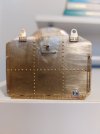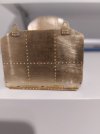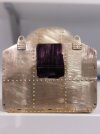spikey faz
Western Thunderer
92021 appears to have had Western Region lamp irons, so I started assembling the supplied etched lamp irons. Fitted the first one along with the rear horizontal and vertical handrails. The lamp irons looked a bit big, but I thought they looked OK. Until I realised the top lamp iron is too high, the vertical hand rails are too tall and the horizontal hand rail is too high! 

I consulted my swear-word compendium, but wasn't able to find suitable words! So I proceeded to remove offending items.

I've marked out new postion for vertical hand rails. I have a feeling the lower hole could come up a bit, but it's staying put. You should be able to see where I'm working out the correct position for the horizontal hand rail.

I'm not keen now on using the etched lamp irons, so suggestions please for replacements (preferably cast). I know Laurie Griffin does some which I think might be OK, but I'm no expert.
Mike


I consulted my swear-word compendium, but wasn't able to find suitable words! So I proceeded to remove offending items.

I've marked out new postion for vertical hand rails. I have a feeling the lower hole could come up a bit, but it's staying put. You should be able to see where I'm working out the correct position for the horizontal hand rail.

I'm not keen now on using the etched lamp irons, so suggestions please for replacements (preferably cast). I know Laurie Griffin does some which I think might be OK, but I'm no expert.
Mike





















